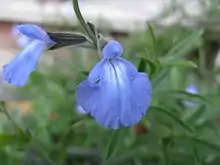Salvia azurea
Salvia azurea, the azure blue sage,[1] azure sage, blue sage or prairie sage, is a herbaceous perennial in the genus Salvia that is native to Central and Eastern North America.[2][3]
| Salvia azurea | |
|---|---|
 | |
| Scientific classification | |
| Kingdom: | Plantae |
| Clade: | Tracheophytes |
| Clade: | Angiosperms |
| Clade: | Eudicots |
| Clade: | Asterids |
| Order: | Lamiales |
| Family: | Lamiaceae |
| Genus: | Salvia |
| Species: | S. azurea |
| Binomial name | |
| Salvia azurea | |
Description

Its thin, upright stems can grow to 6 feet (1.8 m) tall, with narrow, pointed, smooth-edged to serrated, furry to smooth green leaves, connected to their stems by petioles to 0.4 inches (1.0 cm) long. There are no basal leaves.[4]
The blue flowers (rarely white), nearly 1⁄4 to 1⁄2 inch (6.4 to 12.7 mm) long, appear summer to autumn near the ends of their branched or unbranched spikes; their calyxes are tubular or bell-shaped and furry. Two varieties are known, Salvia azurea var. azurea (azure sage) and Salvia azurea var. grandiflora (Pitcher sage).[2][3]
The stems of wild S. azurea tend to be long and unbranched, causing them to flop under the weight of their flowers.[5][6][7] When grown in cultivation, the stems of S. azurea are sometimes cut back early in the growing season to encourage branching and slow the vertical growth of the plant to prevent lodging.[5][6]
Distribution and habitat
S. azurea is found from Utah east to Connecticut and from Minnesota south to Florida.[1][5] S. azurea var. azurea tends to be found in the eastern and southeastern portion of this range, while S. azurea var. grandiflora is found in the west and northwest.[6] In some states within its native range, it has become especially rare, such as in Illinois, where it is listed as a threatened species.[7]
Throughout its range, it is found growing wild on roadsides, glades, prairies, savannas, fields and pastures.[4][5] S. azurea prefers dry, sunny conditions in a variety of soils, including clay, gravel, and loam.[7][6] In wetter conditions, the plant will still grow and bloom, but tends to lodge.[7][6]
Varieties
- Salvia azurea var. azurea - azure sage
- Salvia azurea var. grandiflora - Pitcher sage
- Salvia azurea var. grandiflora 'Nekan' - seed selection released in 1977 by Manhattan Plant Materials Center of Manhattan, Kansas, and Nebraska Agriculture Experiment Station in Lincoln, Nebraska. Selected for better performance and more uniform plant growth.[8]
References
- USDA, NRCS (n.d.). "Salvia azurea". The PLANTS Database (plants.usda.gov). Greensboro, North Carolina: National Plant Data Team. Retrieved 28 October 2015.
- Kathleen N. Brenzel, Editor, Sunset Western Garden Book (Menlo Park, CA: Sunset Publishing Corporation, 2001; ISBN 0-376-03875-6)
- Mark Griffiths, Index of Garden Plants, 2nd American Edition. (Portland, Oregon: Timber Press, 1995; ISBN 0-88192-246-3)
- Carl G. Hunter, Wild Flowers of Arkansas. 6th edition, p. 192. (Little Rock, Arkansas: The Ozark Society Foundation, 2001; ISBN 0-912456-16-7)
- "Salvia azurea (Pitcher sage)". Lady Bird Johnson Wildflower Center - The University of Texas at Austin. Retrieved 2018-10-15.
- "Salvia azurea - Plant Finder". www.missouribotanicalgarden.org. Retrieved 2018-10-15.
- "Wild Blue Sage (Salvia azurea grandiflora)". www.illinoiswildflowers.info. Retrieved 2018-10-15.
- Wynia, Richard. "Pitcher Sage Plant Fact Sheet" (PDF). United States Department of Agriculture Natural Resources Conservation Services.
External links